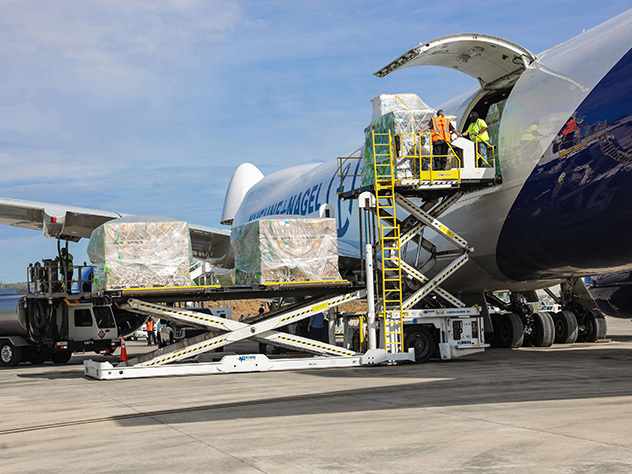The Importance of Air Transportation in the Global Supply ChainAir Transportation in Cargo Industry
Air transportation plays a crucial role in the global supply chain, especially when it comes to shipping goods quickly and efficiently across long distances. With airlines transporting over 52 million metric tons of goods annually, representing more than 35% of global trade by value, air cargo is a vital component of international commerce. Despite accounting for less than 1% of world trade by volume, the value of goods transported by air amounts to a staggering $6.8 trillion annually. Impact of COVID-19 on Air Cargo Industry The air cargo industry, like many others, faced significant challenges due to the COVID-19 pandemic. In 2020, available cargo tonne-kilometers fell industry-wide by 21.4% year-on-year as travel restrictions and reduced demand disrupted operations. However, by the end of the year, cargo tonne-kilometers had nearly returned to pre-pandemic levels, showcasing the resilience of the industry. Certified Home Care Programs Cargo Handling in Air Transport Cargo handling is a critical segment of the supply chain that involves processing goods from the point of origin to their final destination. The Cargo Master Operating Plan (MOP) outlines key processes and sub-processes involved in transporting air cargo systematically and harmoniously. It comprises 19 main processes and 78 sub-processes categorized into five activities to ensure compliance with regulations and safe delivery of shipments. Key Steps in Cargo Handling Process Booking and Planning Shipments: Proper planning is essential for smooth booking and shipment execution. Receiving and Accepting Cargo: A multi-step process involving various stakeholders such as trucking companies and ground handling service providers. Ensuring Safety: Clear labeling, suitable packaging, and protection measures are crucial throughout the shipment process. Preparing Air Cargo for Flight: Security checks, transit cargo handling, build-up planning, and ramp safety protocols are essential before loading. Loading Aircraft: Following IATA guidelines for aircraft loading, including special cargo arrangements and manifest updates. Unloading Air Cargo: Compliance with rules and regulations during unloading to maintain safety standards. Final Delivery: Transfer to freight forwarder hubs for unloading, checking, dispatching to consignees, and delivery to customers. Significance of IATA Cargo Handling Manual (ICHM) The IATA Cargo Handling Manual (ICHM) provides airline stakeholders with recommended practices for efficient cargo handling from shipper to consignee. With 19 chapters aligned with the MOP and up-to-date regulations, the manual ensures compliance with industry standards while streamlining operations across different airlines. In conclusion, air transportation is a vital link in the global supply chain, facilitating rapid movement of goods across borders. Effective cargo handling processes outlined in the MOP and supported by manuals like ICHM are essential for ensuring safe, secure, and compliant air cargo operations. Top 3 Authoritative Sources Used: International Air Transport Association (IATA) Airports Council International (ACI) World Trade Organization (WTO) These sources provide comprehensive insights into air transportation trends, industry guidelines, and global trade dynamics that shape the air cargo sector’s landscape.
Air Cargo Insurance: Protecting Your Shipments
When it comes to shipping goods through air transportation, ensuring the safety and security of your cargo is paramount. At International Courier Cargo Shipping, we understand the importance of safeguarding your shipments against potential risks during transit. That’s why we offer comprehensive air cargo insurance to provide you with peace of mind and financial protection in case of unforeseen events. Why Air Cargo Insurance Matters Air cargo insurance serves as a crucial safety net for businesses and individuals involved in shipping goods via air transport. While carriers may provide basic liability coverage, it often falls short in fully protecting valuable or delicate items. By investing in air cargo insurance, you can mitigate risks associated with damage, loss, theft, delays, and other potential issues that may arise during transit. Certified Home Care Programs Types of Air Cargo Insurance Coverage At International Courier Cargo Shipping, we offer various types of air cargo insurance to cater to different needs and preferences: Type A (All-Risk Insurance): This comprehensive coverage protects against a wide range of risks, including damage, loss, theft, and more. While premiums may be higher, the level of protection is extensive. Type B (Average Insurance): This type provides coverage for average losses incurred during transit at a lower premium cost compared to Type A. Type C (Free of Particular Average Insurance): Offering coverage for total losses only, Type C is the most affordable option but may not protect against partial damages. Calculating Insured Value Determining the insured value of your shipment is essential for setting appropriate coverage limits. Typically, you can estimate the insured value by adding the invoice value of the goods to the freight cost, with an additional percentage for miscellaneous expenses. It’s crucial to refer to your insurance policy for specific guidelines on valuation methods. Benefits of Air Cargo Insurance from International Courier Cargo Shipping Comprehensive protection against damage, loss, theft, and delays Tailored insurance solutions based on your cargo’s value and nature Peace of mind knowing that your shipments are safeguarded throughout their journey Ensure the safety and security of your air cargo shipments with our reliable and customizable insurance options at International Courier Cargo Shipping. Top 3 Authoritative Sources Used in Answering this Question: Investopedia The Balance Small Business Federal Trade Commission (FTC) These sources provided detailed insights into air cargo insurance policies, coverage types, valuation methods, and the importance of protecting shipments during transit via air transportation.

